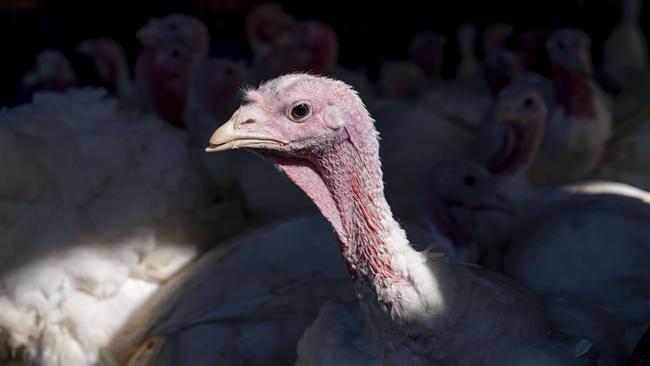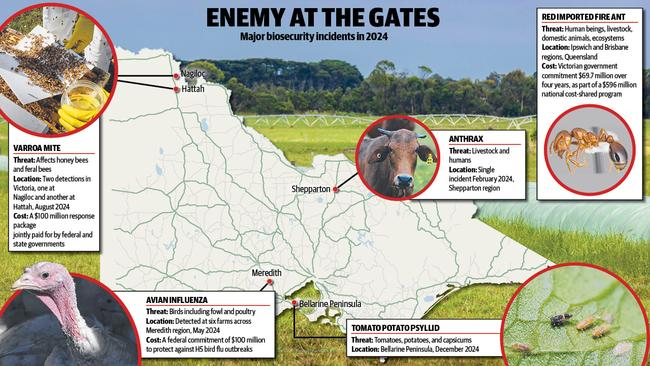Victoria’s biosecurity scoresheet for 2024
From anthrax to avian flu, Victoria has faced a number of threats to the state’s agriculture sector throughout 2024.
From animal diseases to plant pests, biosecurity risks remain a threat to Victorian agriculture heading into the new year, following a number of incursions detected in the state’s borders throughout 2024.
Pests and diseases such as avian influenza, varroa mite, and anthrax were noted threats throughout 2024, with Agriculture Victoria and industry responding to the outbreaks statewide.
The department did not provide a figure when asked by The Weekly Times how many biosecurity incursions occurred in Victoria in the past year.
However, it is understood the department undertook more than 8300 inspections, audits, and investigations of plants, animals, chemicals and invasive species in 2023-24.
Victoria’s biosecurity incursions rose from 10 recorded in 2015-16, peaking at 20 in 2020-21, and sat at 12 incursions in 2022-23.
The most recent threat, tomato potato psyllid, has resulted in the declaration of a restricted area of control in late December for the Bellarine, Port Bellarine, and St Leonards region of Victoria.
Plant pest incursions the department is presently responding to include potato cyst nematode, Phylloxera, green snail, tomato yellow leaf curl virus, and chestnut blight.
A department spokesperson said Agriculture Victoria operated in a national biosecurity system, “where our responsibility is to monitor for pests and diseases, control and eradicate, and manage animal welfare within our borders”.

“This requires collective efforts across government, industry and community to undertake surveillance and swiftly detect exotic pests and diseases and implement targeted controls to protect food supplies, communities, and the environment.”
“We’re continuing to strengthen our biosecurity system to support the agriculture sector to plan and prepare for potential incursions, identify biosecurity threats and respond quickly and effectively to emergencies and outbreaks.”
Invasive Species Council principal policy analyst Carol Booth said Australia faced “a constant stream of new invaders”, with many new incursions often detected by members of the public.
“In one way (incursions are) inevitable, but because inaction or inadequate prevention is so costly, we need to do as much as possible to prevent these incursions,” Dr Booth said.
“We certainly have a strong sense the number of incursions has increased over time. For ants, that’s definitely been the case … the Australian community is spending hundreds of millions of dollars trying to eradicate those that can be eradicated, and future generations will have to spend millions on control.”

Incursions and outbreaks in 2024 include:
VARROA MITE:
Following more than 18 months of eradication efforts, the National Management Group for varroa mite announced a transition from eradication to management in September 2023, with all Australian states and territories committing to the approach. Agriculture Victoria confirmed two varroa mite detections in hives through 2024, one at a Nagiloc property, and a second at Hattah. A $100m response package will be jointly paid for by federal, state and territory governments as industry transitions to management.
TOMATO POTATO PSYLLID:
Tomato potato psyllid – a sap-sucking pest insect that targets plants such as potatoes, tomatoes and capsicums – was detected in a glasshouse tomato production facility on the Bellarine Peninsula in late December 2024. TPP was first detected in Western Australia in February 2017, and it was agreed the pest was not eradicable.
ANTHRAX: Anthrax was detected at a single beef property in the Shepparton region in February 2024, resulting in the death of five cattle.
AVIAN INFLUENZA:
H7 avian influenza was detected at six farms across the Meredith region of Victoria in 2024. The Federal government made a $100m investment to protect against any H5 bird flu outbreaks, incorporated into several government non-government, and industry groups.
Agriculture Victoria has now lifted the control area around Meredith that was put in place for the current H7 avian influenza outbreak.
RED FIRE ANT:
Imported red fire ant remains an active threat to Australian agriculture, with the destructive pest active in parts of Queensland, including the Ipswich and Brisbane regions. In late 2023, the Victorian government committed $69.7m over the next four years to help the national fight the pest. The commitment was part of the $596m national cost-shared program.





